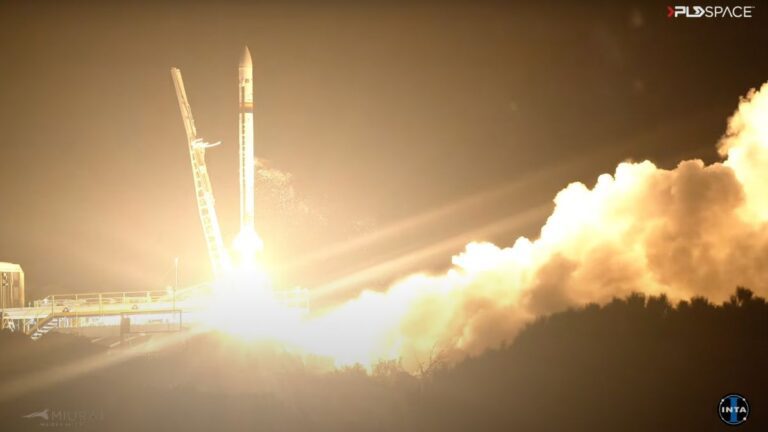
[ad_1]
Spanish company PLD Space now has one launch under its belt.
PLD Space’s Miura 1 suborbital rocket lifted off today from the El Arenosillo Test Center at the National Institute of Aerospace Technology in Huelva, Spain, at about 8:19 p.m. EDT (0019 GMT and 0219 local time in Spain on Oct. 7).
The mission was scheduled to last 12 minutes and get 50 miles (80 kilometers) above Earth’s surface — the altitude at which space begins, according to NASA and the U.S. military. (That’s not universally accepted, however; some organizations go with the Kármán line, which lies 62 miles, or 100 km, up.)
Miura 1 — which is named after a type of fighting bull — didn’t get that high, topping out at about 29 miles (47 km), according to the mission webcast. But the rocket performed well enough on its first-ever test flight to have PLD Space employees celebrating.
Related: European spaceflight companies are racing to be the first to reach orbit

The Miura 1 is a single-stage rocket that stands 41 feet (12.5 meters) tall. It can carry about 220 pounds (100 kilograms) of payload on brief flights to suborbital space.
Miura 1 carried a payload on its debut mission — an experiment from the German Center of Applied Space Technology and Microgravity that studied microgravity conditions during the flight, according to PLD Space. The company also put photos of its employees on board to mark the milestone moment.
The mission ended with Miura 1’s splashdown into the Atlantic Ocean. PLD Space had boats in the area, which aimed to recover the vehicle for inspection and analysis.
We’ll learn more about the recovery effort, and the results of the flight, in the coming hours and days, after PLD Space has had time to analyze data.
The Miura 1 is the first European rocket that’s designed to be recoverable. PLD Space aims to learn a great deal about the vehicle from tonight’s test mission, to inform future flights of the Miura 1 and to aid the development of the Miura 5, the company’s planned orbital launcher.
The Miura 5 could launch as soon as 2024 or 2025, if everything goes well. The orbital rocket, which features a reusable first stage, will fly from Europe’s Spaceport in Kourou, French Guiana.
Tonight’s launch wasn’t be the first attempt for the Miura 1. An initial try on June 17 was aborted 0.2 seconds before liftoff, after ground software determined that one of the cables connecting the rocket to its launch tower hadn’t disconnected in time. PLD Space’s investigation subsequently found that the cable had indeed been released, but 0.1 seconds later than planned.
The Miura 1 liftoff was one of four space missions planned for today. Already in the books today are Virgin Galactic’s fourth commercial space tourism mission and the launch of Amazon’s first two prototype internet satellites atop a United Launch Alliance Atlas V rocket. France-based company Arianespace aimed to loft 12 satellites tonight at 9:36 p.m. EDT (0136 GMT on Oct. 7) with its Vega rocket, but that attempt was scrubbed late in the countdown clock.
Editor’s note: This story was updated at 9 p.m. EDT on Oct. 6 with the results of tonight’s flight.
[ad_2]